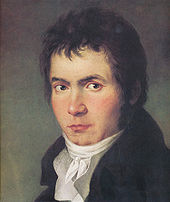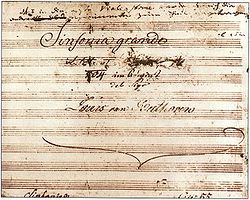You are here
Beethoven’s Heroic ‘Eroica’
 The Third Symphony by Beethoven is one of the most famous and radical works of art ever created. It was “one of the turning points in musical history,” according to Harold Schoenberg, one-time senior music critic for The New York Times. Patrons at the Vienna premiere in April 1805 must have had “an experience…that was an electrifying, frightening encounter with revolution, with a force sufficient to blast doors and windows out of the room,” wrote critic Michael Steinberg in his book The Symphony.
The Third Symphony by Beethoven is one of the most famous and radical works of art ever created. It was “one of the turning points in musical history,” according to Harold Schoenberg, one-time senior music critic for The New York Times. Patrons at the Vienna premiere in April 1805 must have had “an experience…that was an electrifying, frightening encounter with revolution, with a force sufficient to blast doors and windows out of the room,” wrote critic Michael Steinberg in his book The Symphony.
 The “Eroica,” as Beethoven called it, marks an enormous departure from the classical symphonies that came before. At 50 minutes, it was nearly twice the length of the average Haydn and Mozart symphony. Its fiercely dissonant harmonies, unexpected notes and phrases, slow movement funeral march and fiendishly difficult passages challenged musicians, puzzled audiences and angered critics. One writer, an admirer of Beethoven’s earlier work, said after the premiere that the symphony “lost itself in lawlessness, …[there is] too much that is glaring and bizarre, hindering greatly one’s grasp of the whole.”
The “Eroica,” as Beethoven called it, marks an enormous departure from the classical symphonies that came before. At 50 minutes, it was nearly twice the length of the average Haydn and Mozart symphony. Its fiercely dissonant harmonies, unexpected notes and phrases, slow movement funeral march and fiendishly difficult passages challenged musicians, puzzled audiences and angered critics. One writer, an admirer of Beethoven’s earlier work, said after the premiere that the symphony “lost itself in lawlessness, …[there is] too much that is glaring and bizarre, hindering greatly one’s grasp of the whole.”
The symphony was famously dedicated to Napoleon Bonaparte, but when the French general crowned himself emperor in 1804, Beethoven furiously scratched the dedication off the music’s title page.
Come hear the Evanston Symphony perform this most famous piece of music, along with Samuel Barber’s delightful Overture to The School for Scandal and Bruch’s magnificent Violin Concert No. 1 in G Minor. Evanston's own Sang Mee Lee, virtuoso violinist and chair of the strings department at the Music Institute of Chicago, will be the soloist.
The performance will take place at 2:30 p.m. on Sunday, May 4 at Pick-Staiger Concert Hall in Evanston. For more information and to purchase tickets, go to www.evanstonsymphony.org or call 847-864-8804.